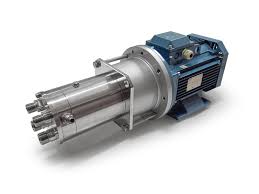How to Choose the Right Type of High Pressure Pump and Avoid Costly
2024-07-29
Choosing the right type of high-pressure pump is crucial for ensuring efficient performance and avoiding costly mistakes. High-pressure pumps are used in various applications, including industrial processes, water blasting, and hydraulic systems. Here’s a guide to help you select the appropriate pump and avoid common pitfalls:
1. Understand Your Requirements:
- Application: Determine the specific use of the pump (e.g., water jetting, hydraulic systems, chemical transfer).
- Pressure Needs: Identify the required pressure output. High-pressure pumps are typically classified by their pressure ratings.
- Flow Rate: Consider the flow rate needed for your application. This is the volume of fluid the pump needs to move within a certain time.
- Fluid Type: Determine the type of fluid being pumped (water, chemicals, oil, etc.) and its properties (viscosity, temperature, abrasiveness).
2. Types of High-Pressure Pumps:
- Reciprocating Pumps:
- Function: Use a piston to move fluid through a cylinder. Known for high pressure and relatively low flow rates.
- Best For: Applications requiring very high pressures and precise control.
- Centrifugal Pumps:
- Function: Use a rotating impeller to move fluid. More suitable for applications with lower pressures but higher flow rates.
- Best For: General industrial applications where high flow rates are needed.
- Diaphragm Pumps:
- Function: Use a flexible diaphragm to move fluid. Good for handling abrasive or corrosive fluids.
- Best For: Chemical processing and applications requiring high pressure and resistance to corrosive fluids.
- Peristaltic Pumps:
- Function: Move fluid through a flexible hose by compressing it with rollers. Suitable for handling delicate or shear-sensitive fluids.
- Best For: Applications requiring gentle handling of fluids and precise flow control.
- Plunger Pumps:
- Function: Similar to reciprocating pumps but use a plunger for fluid movement. Can handle high pressures and flow rates.
- Best For: Heavy-duty industrial applications with high pressure and moderate to high flow requirements.
3. Key Specifications:
- Pressure Rating: Ensure the pump can handle the maximum pressure required by your application. Consider both the operating pressure and any potential surges.
- Flow Rate: Match the pump’s flow rate with the required volume of fluid movement.
- Material Construction: Choose materials that are compatible with the fluid being pumped (e.g., stainless steel for corrosive fluids).
- Power Source: Consider the power requirements (electric, diesel, hydraulic) and ensure compatibility with your setup.
4. Efficiency and Performance:
- Energy Efficiency: Look for pumps with high efficiency ratings to reduce energy consumption and operational costs.
- Maintenance Needs: Consider the ease of maintenance and availability of replacement parts. Regular maintenance is essential to prolong the pump’s lifespan.
5. Avoiding Costly Mistakes:
- Oversizing/Undersizing: Avoid choosing a pump that is too large or too small for your needs. Oversizing can lead to higher initial costs and operational inefficiencies, while undersizing can result in inadequate performance and potential damage.
- Ignoring Fluid Properties: Failing to consider the fluid’s characteristics (e.g., corrosiveness, abrasiveness) can lead to premature wear or pump failure.
- Neglecting System Integration: Ensure the pump integrates well with existing systems and infrastructure. Consider factors like piping, pressure loss, and overall system compatibility.
- Ignoring Manufacturer Support: Choose a pump from a reputable manufacturer with good support and warranty services. This can help address issues quickly and avoid long-term costs.
- Not Considering Total Cost of Ownership: Evaluate not just the purchase price but also the long-term costs of operation, maintenance, and potential repairs.
6. Consulting Experts:
- Professional Advice: Consult with pump specialists or engineers to ensure you select the right pump for your specific needs.
- Site Assessment: Have a professional assess your site conditions and application requirements to make an informed decision.
7. Testing and Validation:
- Pilot Testing: If possible, conduct a pilot test with the pump to validate its performance before making a full purchase.
- Performance Verification: Ensure the pump meets all required performance specifications under actual operating conditions.
By carefully considering these factors and seeking professional guidance, you can choose the right high-pressure pump that meets your needs effectively and avoids costly mistakes.



